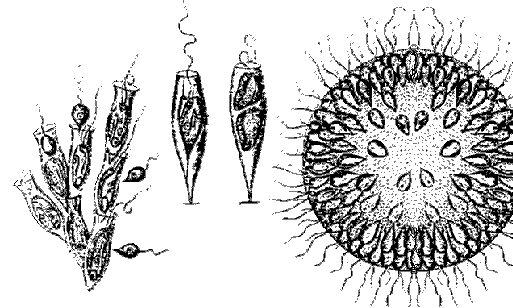Introduction to the Chrysophyta
Golden Algae


Chrysophytes, or golden algae, are common microscopic chromists in fresh water. Some species are colorless, but the vast majority are photosynthetic. As such, they are particularly important in lakes, where they may be the primary source of food for zooplankton. They are not considered truly autotrophic by some biologists because nearly all chrysophytes become facultatively heterotrophic in the absence of adequate light, or in the presence of plentiful dissolved food. When this occurs, the chrysoplast atrophies and the alga may turn predator, feeding on bacteria or diatoms.
There are more than a thousand described species of golden algae, most of them free-swimming and unicellular, but there are filamentous and colonial forms. Other chrysophytes may spend part of their life as amoeboid cells. At the left and center of the above illustration is Dinobryon, a freshwater genus in which the individual cells are surrounded by vase-shaped loricae, composed of chitin fibrils and other polysaccharides. The colonies grow as branched or unbranched chains. A spherical colonial form, Synura, is on the right; the surfaces of these cells are covered by silica scales. Species which produce siliceous coverings may have bristles or scales with quite complex structure. Some researchers group the chrysophytes with silica scales in a separate taxon, the Synurophyceae.
The oldest known chrysophytes are from calcareous and siliceous deposits of Cretaceous age, but they reached their greatest diversity in the Miocene. The group actually has a fairly complete fossil record, because most freshwater chrysomonads secrete resting cysts of silica, which may be abundant in certain rocks -- in some Paleocene deposits, chrysophyte cysts outnumber the diatoms! The fossils of chrysophytes, like those of diatoms and coccolithophorids, are often used as paleoecological indicators to reconstruct ancient environments.
It is now generally believed that the Chrysophyta is a heterogeneous group, probably paraphyletic. Several groups formerly included here have been given separate recognition, such as the Raphidiophyceae, Eumastigophyceae, Xanthophyceae, Silicoflagellata, Sarcinochrysophyceae, and others. However, there is as yet no general consensus as to how these groups are related to each other or to the other chromist groups.
For more information on a typical chrysophyte, Poterioochromonas, visit the Protist Image Database at the University of Montreal.


